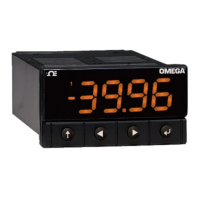PLATINUM
TM
Series User’s Guide
Reference Section: Initialization Mode (INIt)
Select the indicated option.
4.1.3 Thermistor Input Type Configuration (INIt > INPt > tHRM)
Select Thermistor (tHRM) as the input type. This sets up the unit for thermistor-based
temperature measurement and then the specific thermistor type can be specified. If no
thermistor type is specified, the last selected type is used.
Navigate to the correct setting. Settings include the following:
• 2.25k – 2,250 Ω thermistor (factory default)
• 5k – 5,000 Ω thermistor
• 10k – 10,000 Ω thermistor
Select the indicated option.
4.1.4 Process Input Type Configuration (INIt > INPt > PRoC)
Select Process (PRoC) as the input type. Then select the process input range and scale it. If
you stop after selecting the PRoC input type, the last selected input range and scaling is used.
Navigate to the voltage or current range of the process input. Any signal input outside of the
specified hardware input range will result in an “out-of-range” error (code E009). Input range
choices include the following:
• 4–20 – 4 mA to 20 mA (factory default)
• 0–24 – 0 mA to 24 mA
• +–10 – -10 V to +10 V
• +–1 – -1 V to +1 V
• +–0.1 – -1 mV to +1 mV
Select the desired range.
Choose either manual or live scaling. The scaling functions translate process values to
engineering units and are available for all process input ranges. The defaults for each input
range are the hardware minimum and maximum. Scaling methods include the following:
• MANL – User manually enters all four scaling parameters
• LIVE – User manually enters the low and high display values (RD.1 and RD.2) but
reads the input signal directly to set the low and high input values (IN.1 and IN.2)
Scaled values are calculated as:
Scaled Value = Input * Gain + Offset, where:
Gain = (Rd.2 – Rd.1) / (IN.2 – IN.1)
Offset = Rd.1 – (Gain * IN.1)
Therefore scaling can be done over a subset of the applicable range as this scaling calculation
linearly extrapolates in both directions.
Select the scaling method to be used.
Omega Engineering | www.omega.com

